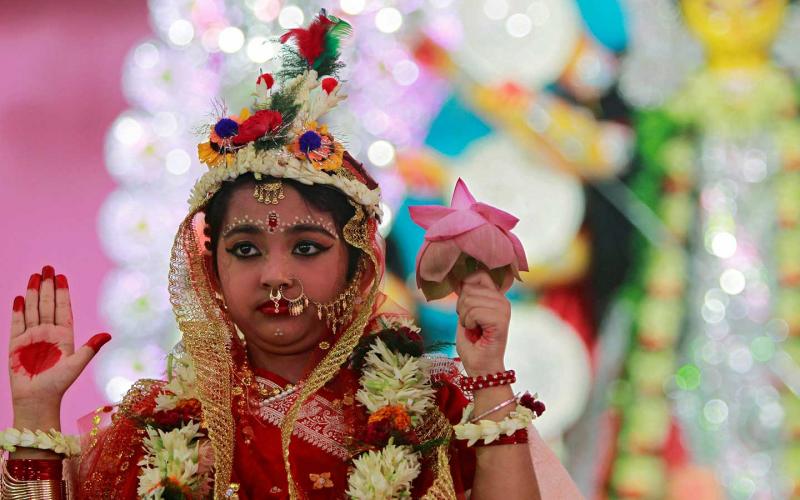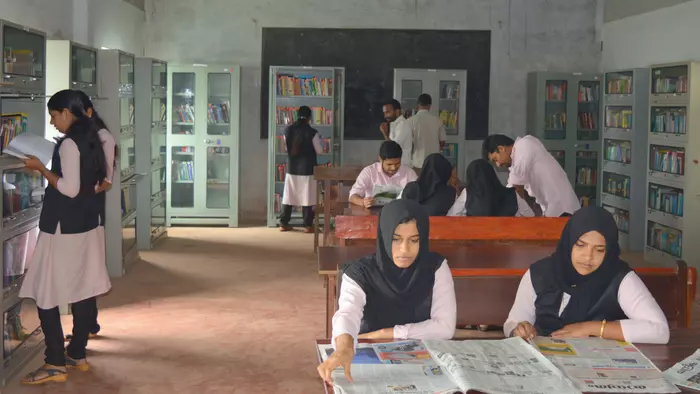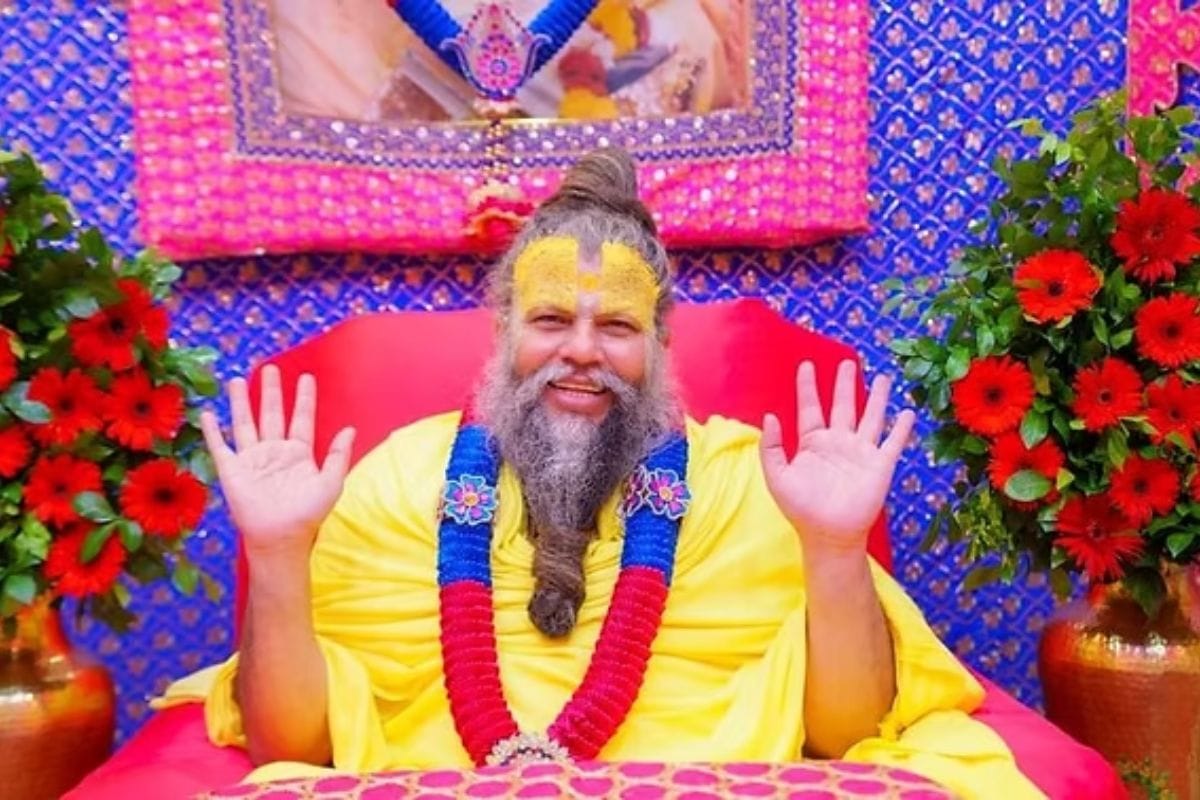The practice of worshipping young prepubescent girls is not new in Hinduism and has over time trickled down and spread out to different sects and faiths within Hinduism as has the meaning and traditions involved with it changed.

The core belief behind this comes from a regressive and currently criticized narrative of Hinduism placing a higher value on a young girl who has not started menstruating yet. While shedding of blood is the most natural process to occur in female bodies and is the reason why they are equipped for child birth in the first place, thus acquiring the rights to be called “Maa” or mother for all her children – in a stark irony, the scriptures and tradition abhor the young woman who is fertile, who is ready to give birth, who has reached puberty.
The core belief behind this comes from a regressive and currently criticized narrative of Hinduism placing a higher value on a young girl who has not started menstruating yet.
Only the temple of Kamakhya Devi in Assam acknowledges and recognizes that Goddess Kamakhya (or Shakti) is also a blood and flesh woman who menstruates once a year. Even then, the connotations of purity do not go away. For those 3 days that the Goddess is said to menstruate, priests do not worship her, the “yoni” stone is covered by a red cloth and the Goddess is secluded as she is unclean. At the end of the 3rd day, she is bathed and cleaned again as she retrieves her purity because she will no longer be menstruating.
Following this belief of purity and impurity depending upon menstruation, it is no wonder that Kumari Puja/Kanya Pujan is given such a huge importance throughout India and also Nepal. In India, Kumari Puja or Kanya Puja mostly happens in West Bengal as a part of Durga Puja while it happens in North India during Navratri. Nepal, on the other hand, has a very different process and culture of Kumari Puja.
Kumari Puja in West Bengal
On the 8th day of Durga Puja or Maha Ashtami, almost every Puja consists of the ritual of Kumari Puja. According to tradition, a young Brahmin girl is chosen to be the Kumari. She is bathed in holy water, dressed up like a Goddess in red or yellow saree with a red border and is also adorned like a Goddess in ornaments. She is then worshipped with mantras following scriptures and rituals just like the idol of Durga is. The belief behind it lies in the fact that in a young girl lies the essence of Devi or the true feminine power that rules the earth. Young girls before they attain puberty are pure physically and also mentally and spiritually. This is the time that they are believed to be far removed from all materialistic aspects of life and hence, embody the spirit of Devi Shakti and are fit to be worshipped as personifications of the Goddess.
Kumari Puja of Belur Math, the headquarters of Ramkrishna Mission is the most well-known instance of such worship and is rich with history. Ramkrishna himself used to worship his own wife, Sarada Mani as a Devi – a mother and also as a child. Swami Vivekananda, Ramkrishna’s famous disciple first started the practice of Kumari Puja in Belur Math. Every year on Ashtami, the saffron clad monks find a small child and worship her as the Divine Mother. She is “purified” and “sanctified” through mantras and then an arati is performed after which all devotees offer flowers to her and seek her blessings.
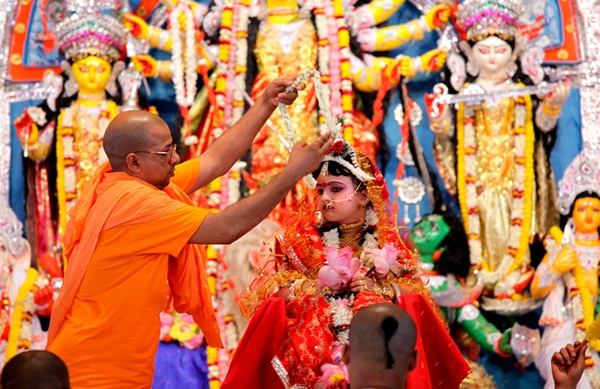
While girls from non-Brahmin castes were also selected to be Kumari, in 2019, the Dutta family of Arjunpur in West Bengal took a remarkable decision by inviting Fatima, a Muslim girl, to be their Kumari as she was worshipped just like any other Hindu Brahmin girl – spreading a message of inclusivity and communal harmony.
Kanya Pujan in North India
On the 9th day of Navratri, nine young girls are chosen to represent each forms of Goddess Durga and they are worshipped with incense sticks and given offerings of rice to please the ultimate deity. The same conditions of physical purity and “innocence” are also applied here. The selection is not very narrow as girls from different castes can be chosen depending on what the devotees want to achieve through the Puja.

Kumari Puja in Nepal
In Nepal, Kumari Puja is not just a one-day celebration but embedded deeper within its religious culture as a small girl is chosen to be the Kumari and she stays in that position till she attains puberty. Kumari is a manifestation of Divine Mother and is worshipped in both Hindu and Buddhist traditions. A prepubescent girl (who is Buddhist by birth) is chosen from the Shakya caste or Bajracharya clan of Nepalese Newari community and then worshipped by the Hindus. As of 2017, the Royal Kumari is Trishna Shakya, aged three, installed in September 2017 by the Maoist government that replaced the monarchy. The monarchy also worshipped the Kumari and took blessings from her, now the Prime Minister and the President take blessings.
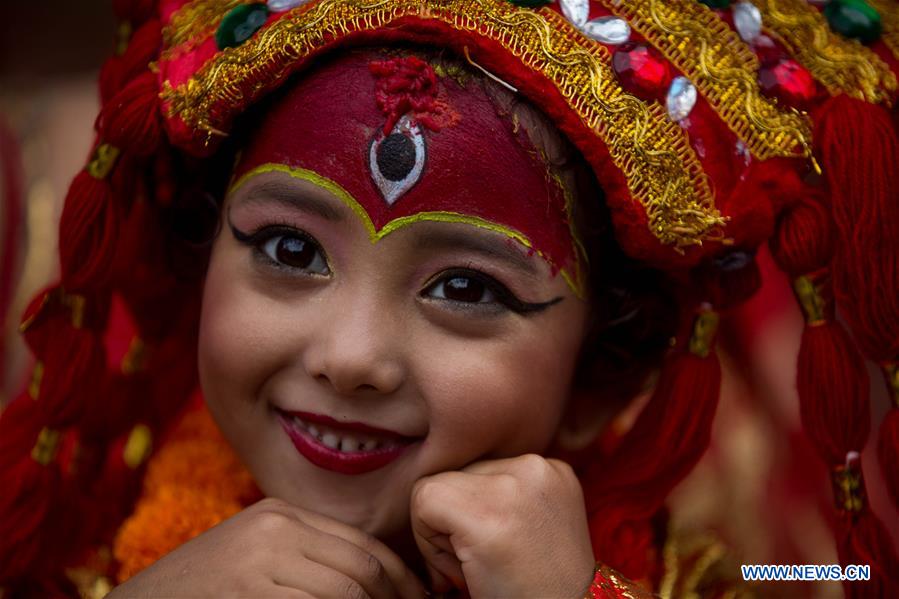
Nepal has its own mythology behind the practice of Kumari Puja as the young girl chosen is believed to be the incarnation of Goddess Taleju and any major physical illness or blood loss is believed to be loss of divinity in that Kumari followed by the rigorous search of another Kumari who can be worshipped again. There are several stories that attribute King Jayaprakash Malla as the one who started this practice as he had angered Goddess Taleju. Later as she was pacified, the Goddess told him that she would reappear in a young girl and the King started the practice.
Nepal has its own mythology behind the practice of Kumari Puja as the young girl chosen is believed to be the incarnation of Goddess Taleju and any major physical illness or blood loss is believed to be loss of divinity in that Kumari followed by the rigorous search of another Kumari who can be worshipped again.
The tradition is quite peculiar as the Kumari is no longer just a normal child but is elevated to the position of a Goddess. She is secluded with family members being allowed to visit sometimes and has her own caretakers looking after her. She is not allowed to touch her feet upon the ground but can only travel through palanquins or atop someone’s shoulders. When devotees offer her gifts, her reactions are considered to be predictive of their future. If she cries or laughs loudly, the devotee may expect serious illness or death. If she is trembling, then the devotee may face imprisonment. If the Kumari accepts the worship stoically, the devotee shall face no harm and is satisfied.
Also read: Durga Puja And The Myth Of Worshipping “Nari Shakti”
The selection process is also meticulous as girls from only the Newari Bajracharya clan can be selected. The child must have certain physical specifications (neck like a conch shell, voice soft and clear as a duck’s), never been afflicted by any diseases and also not have any blemishes on her body. After such girls are found, they are then made to go through “mental” tests of sitting in the same place as sacrificed animal heads and men in masks – if the child does not shout in fear, it is considered that the Devi has overtaken her and she is truly pure and spiritual, worthy to be worshipped.

While these Kumaris were not allowed education before as they were considered omniscient, they are now allowed to go to schools or taught with the help of private tutors. They are also allowed playmates to have the resemblance of a normal life. Boys are however kept in distance because the Kumari cannot have any “impure” thoughts or that would render her impure.
As much is not known about these Kumaris and their psychological conditions during their formulative years, it is hard to put a judgement on whether it violates a child’s rights (as most children cannot possibly consent to such a practice at such a tender age) or not, precisely because they are taken care of and are also given stipends by the government for their service once they “retire”. While one Kumari later confessed to feeling like a higher, spiritual being during her years, it is also hard to determine if there really is a spirit or higher consciousness in power or if people put a huge onus, of life and death, on a small girl without wondering about the consequences and ramifications.
Personification of any deity on a living, breathing, human individual requires the automatic ascription of the heavenly responsibility of tough decision making on that person, directly or indirectly.Most of the times, in all these cases, the girl child’s spirituality is not the main contentious point for her selection but her birth is – her caste, her religion. Her physical conditions are also thoroughly inspected because a Goddess cannot be flawed.
Also read: The Paradox Of Hindu Goddess Worship And Feminism
The worshipping of feminine power only through the “pure” medium of a prepubescent girl while actively degrading menstruating women is an unexplainable dichotomy that resides in Hinduism. Building a temple for Kumari Mata, and then not allowing menstruating women inside for fear of polluting the temple is a cruel irony without doubt.
Featured Image Source: Prothom Alo
About the author(s)
Sukanya Bhattacharya is a postgraduate student at Tata Institute of Social Sciences, Mumbai. She is interested in looking at feminism and gender through the lenses of popular culture, social media and urban spaces. She has written for 'Asia in Global Affairs' and has also been a volunteer at 'Calcutta Rescue'. She is also an avid debater and a quizzer.
